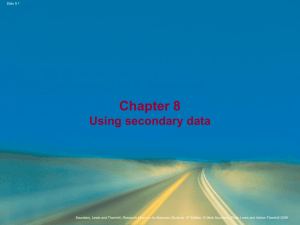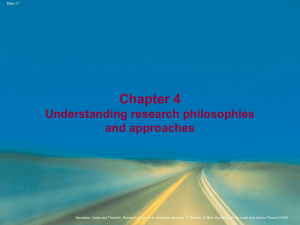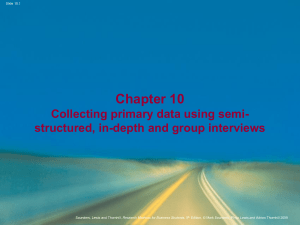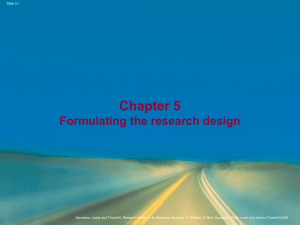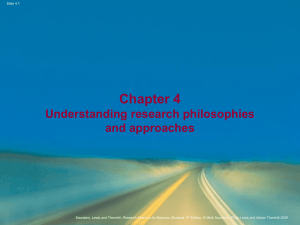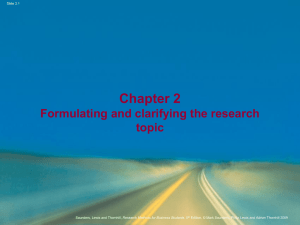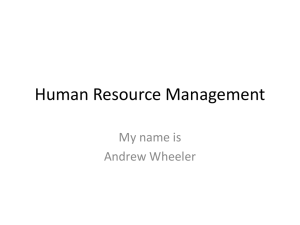Chapter 6
advertisement
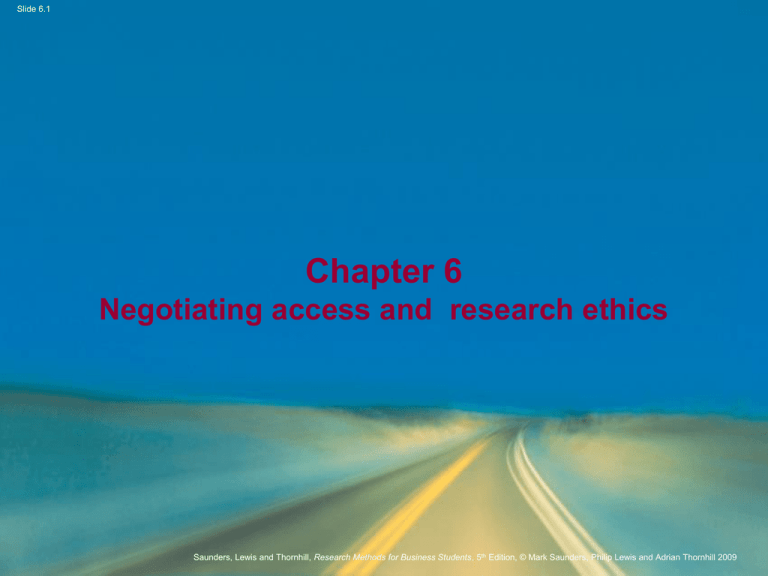
Slide 6.1 Chapter 6 Negotiating access and research ethics Saunders, Lewis and Thornhill, Research Methods for Business Students, 5th Edition, © Mark Saunders, Philip Lewis and Adrian Thornhill 2009 Slide 6.2 Gaining access to data (1) Physical access – key issues • Organisations may not wish to allocate resources • Requests for access may not be of sufficient interest • Failure to reach those who can give permission • Concerns about sensitivity and confidentiality • Perceptions about the researcher’s credibility • Doubts about the researcher’s competence Saunders, Lewis and Thornhill, Research Methods for Business Students, 5th Edition, © Mark Saunders, Philip Lewis and Adrian Thornhill 2009 Slide 6.3 Gaining access to data (1) Cognitive Access It means that not only is important to gain Physical access but after that to obtain information that would help you in your research to reach your research objective. Physical access is granted by management, while cognitive access will depend on how the participants in your research accept you, trust you, and provide you with the needed correct information. Saunders, Lewis and Thornhill, Research Methods for Business Students, 5th Edition, © Mark Saunders, Philip Lewis and Adrian Thornhill 2009 Slide 6.4 Gaining access to data (3) Virtual access - four types of online community • Bulletin boards for particular products or services • Independent web pages • Themed email lists • Multiuser chat rooms Adapted from Kozinets (2002) Saunders, Lewis and Thornhill, Research Methods for Business Students, 5th Edition, © Mark Saunders, Philip Lewis and Adrian Thornhill 2009 Slide 6.5 Gaining access to data (4) Checklist Box 6.8 Complete the Checklist in Box 6.8 to help you gain access Saunders et al. (2009) Saunders, Lewis and Thornhill, Research Methods for Business Students, 5th Edition, © Mark Saunders, Philip Lewis and Adrian Thornhill 2009 Slide 6.6 Strategies to gain access (1) Areas for consideration • Ensuring familiarity and understanding with the characteristics of the organization or group. • Allowing sufficient time for contacting and carrying the research • Using existing contacts and developing new ones • Giving a clear account of purpose will allow those you are contacting to be at ease wherever you are in the access process Saunders, Lewis and Thornhill, Research Methods for Business Students, 5th Edition, © Mark Saunders, Philip Lewis and Adrian Thornhill 2009 Slide 6.7 Strategies to gain access (2) Areas for consideration • Overcoming organisational concerns: amount of time or resources involved, sensitivity about the topic, confidentiality and anonymity of org or participants. • Identifying possible organisational benefits which may help you obtain approval of access. • Establishing researcher credibility will be needed to access cognitive information. Saunders, Lewis and Thornhill, Research Methods for Business Students, 5th Edition, © Mark Saunders, Philip Lewis and Adrian Thornhill 2009 Slide 6.8 Research Ethics (1) Definition ‘The appropriateness of your behaviour in relation to the rights of those who become the subject of or are affected by your work’ Adapted from Saunders et al. (2009) Saunders, Lewis and Thornhill, Research Methods for Business Students, 5th Edition, © Mark Saunders, Philip Lewis and Adrian Thornhill 2009 Slide 6.9 Research Ethics (8) Issues during data collection • General issues applying to techniques • Awareness of participant’s rights • Keeping to the project aims • Safety of the researcher Saunders, Lewis and Thornhill, Research Methods for Business Students, 5th Edition, © Mark Saunders, Philip Lewis and Adrian Thornhill 2009 Slide 6.10 Research Ethics (9) Issues during data collection • Maintaining objectivity, confidentiality and anonymity • Appropriate interview behaviour • Use of observation techniques • Undertaking a covert study Saunders, Lewis and Thornhill, Research Methods for Business Students, 5th Edition, © Mark Saunders, Philip Lewis and Adrian Thornhill 2009 Slide 6.11 Data processing and storage Personal data must be • Processed fairly and lawfully • Obtained for specified purposes • Adequate and relevant • Accurate, updated and kept securely Adapted from Saunders et al. (2009) Saunders, Lewis and Thornhill, Research Methods for Business Students, 5th Edition, © Mark Saunders, Philip Lewis and Adrian Thornhill 2009 Slide 6.12 Data analysis and reporting Related issues • Sensitive personal data • Confidentiality and anonymity • Protection of research participants • Ethical use of data analysis and conclusions Saunders, Lewis and Thornhill, Research Methods for Business Students, 5th Edition, © Mark Saunders, Philip Lewis and Adrian Thornhill 2009 Slide 6.13 Dealing with ethical issues Checklist Box 6.18 Complete the Checklist in Box 6.18 to help you anticipate and deal with ethical issues Saunders et al. (2009) Saunders, Lewis and Thornhill, Research Methods for Business Students, 5th Edition, © Mark Saunders, Philip Lewis and Adrian Thornhill 2009 Slide 6.14 Summary: Chapter 6 • Access and ethics are critical aspects of research • Access may be physical, cognitive or continuing • Feasibility is an important determinant • Potential ethical issues should be recognised Saunders, Lewis and Thornhill, Research Methods for Business Students, 5th Edition, © Mark Saunders, Philip Lewis and Adrian Thornhill 2009 Slide 6.15 Summary: Chapter 6 • Ethical concerns can occur throughout the research • Both qualitative and quantitative research have associated ethical issues • Use of the Internet and email for data generation raises specific ethical issues • Data protection legislation requires researchers to comply with legal requirements Saunders, Lewis and Thornhill, Research Methods for Business Students, 5th Edition, © Mark Saunders, Philip Lewis and Adrian Thornhill 2009
